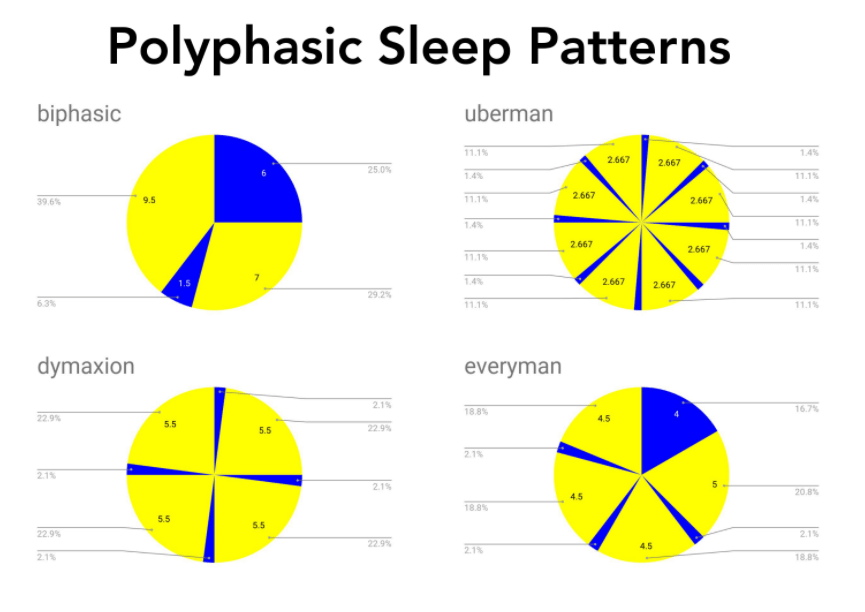
What Is Polyphasic Sleep, and Does Eight Hours of Sleep Really Matter?
There is a strong desire for productivity in today's culture; it's as though "time is money" has a tangible feeling.
People are, paradoxically, returning to an old-fashioned sort of sleep cycle known as polyphasic sleep.
However, it's not just odd entrepreneurs that are challenging the norms of sleep deprivation. According to Live Science, over 33 percent of American adults wake up in the middle of the night on a regular basis.
While some doctors continue to label this habit as "middle-of-the-night insomnia," there is considerable evidence from both historians and psychiatrists that a single eight-hour sleep session may not be the best answer for our body and mind.
What is Monophasic Sleep Vs. Polyphasic Sleep?
To comprehend polyphasic sleep, it's critical to grasp the contemporary ideal for optimal rejuvenation in our society.
The standard eight hours of rest that we hear about most often today is known as monophasic sleep— just one sleep phase followed by a waking period.
Polyphasic sleeping, on the other hand, is about dividing your sleep into numerous periods.
Biphasic and Dymaxion are two examples of polyphasic sleep patterns, which include many naps and/or core sleep sessions (deep sleep and REM) each day.
- Biphasic: A split sleeping schedule with two sessions. Frequently a five to six-hour "core sleep" period followed by a one and a half-hour nap.
- Dymaxion: The four 30-minute naps in the day are a standard feature. There's a total of two hours of sleep.
- Uberman: Occurs when you need to take only a few short naps during the day. Two hours of sleep in total, on average.
- Everyman: A typical four sleep sessions. A three to four-hour core sleep is usually followed by three naps during the day.
What is the history of polyphasic sleep?
Polyphasic sleep — which involves sleeping for several short intervals throughout the day — has been around for centuries. In fact, Russian scientist Konstantin Pavlovich Utochkin was widely considered to be the first person to document his experience with polyphasic sleep.
He lived in an isolated village where he was not exposed to all of the factors that affect sleep cycles in more developed regions, so his body had an easier time sleeping for short periods of time.
Polyphasic sleep is more popularly known as "power napping," and while some individuals say they have experienced negative side effects from it, many experts still support its perceived benefits.
Polyphasic sleep was once the standard, and monophasic sleep was considered an "alternative." According to researcher Roger Ekirch, historian and author of At Day's Close: Night In Times Past, "The standard pattern of sleep, perhaps since time immemorial, was biphasic.... Humans slept in two-four blocks, which were separated by a period of wakefulness in the middle of the night."
These were not brief blips, either. Many individuals would get up and go about their normal (or in some cases nightly) business, as well as converse with neighbours, speak to family, and so on.
As the Industrial Revolution brought forth artificial illumination enhanced by the light bulb, sleep patterns altered drastically. According to Psychology Today , too much bright light stops our bodies from releasing melatonin, a hormone responsible for regulating sleep.
You've probably heard of polyphasic sleep's most well-known supporters, such as Leonardo da Vinci, Thomas Edison, and Nikola Tesla.
Both da Vinci and Tesla practiced the rigorous Uberman technique, which required only 2 hours of sleep per day split into 20-minute naps.
Is Polyphasic Sleep Healthy?
According to Jessa Gamble, author of The Siesta and the Midnight Sun: How Our Bodies Experience Time, there is an "unlimited number of people who want to explore their own sleep."
Despite historical accounts claiming that polyphasic snoozing has health benefits, many specialists believe it is not the most healthy option. Nonetheless, as Eduardo Galeano once remarked, "History never really says goodbye. History says, 'See you later.' "
It appears that polyphasic sleep, or at least biphasic sleep, is making a comeback. After all, the Sleep Foundation claims that 85 percent of mammalian species are polyphasic sleepers.
The majority of people are not meant to sleep in other than monophasic or biphasic sleeping patterns, according to findings from a massive study by SuperMemo.
According to the research, more intense sleep cycles like Uberman and Everyman occur at an increased risk of similar problems as shift workers and jetlagged travellers.
With all of this in mind, biphasic sleep, which deviates the most from the contemporary eight-hour pattern, has been proven to have a number of notable advantages.
Anecdotal evidence appears to indicate that biphasic sleep may improve creativity and attention. It is now considered likely that mania or insomnia caused the creative genius of such historical figures as Tesla or da Vinci, who were attributed to the "Uberman" model.
Possible Dangers of Polyphasic Sleep
- Significant hormone imbalance (particularly in young adult males)
- Lower mental capabilities
- Cars or heavy equipment are difficult to use.
Naps are Still Good
If you doze off during the day, don't be concerned. Naps are safe and healthy, and they may help you feel more alert. A 40-minute nap boosted performance by 34% and alertness 100%, according to a study at NASA on sleepy military pilots and astronauts. Short naps can also assist with:
- Alertness
- Relaxation
- Physical rejuvenation
- Stress
- Tension
- Depression
To Answer the Question
According to a study published in Scientific American, just 5% of the population can survive on only six hours of sleep. That being said, unless you're in the tiny minority, monophasic and biphasic are your best bets if you're choosing between cycles.
Regardless of the sleep schedule you pick, the need for sleep can't be overstated. As a result, AcousticSheep has created the most comfortable SleepPhones in the world. Check out our top-selling models below if you're looking to fall asleep quicker and sleep more soundly.
